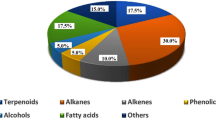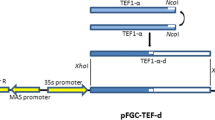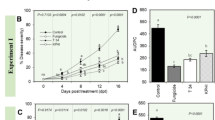Abstract
IN molecular structure, phenobarbitone resembles 6-azauracil which was shown by Dekker1 to exhibit systemic activity against powdery mildew of cucumbers. In the experiments described here, tests of phenobarbitone and related compounds were made on young potted marrow seedlings which had been dusted with conidia by shaking over them leaves heavily infected with powdery mildew, caused by Sphaerotheca fuliginea (Schlecht. ex Fr.) Poll. To assess systemic fungicidal performance, the seedlings, which had previously been left unwatered for 48 h, were watered with the test chemicals immediately after inoculation, at the rate of 150 ml. per pot. Foliage applications were also assessed, the plants being dipped in aqueous solutions containing the test chemical together with the non-ionic wetting agent, ‘Ethylan CP’ (0.0025 per cent v/v), at a temperature of 30° C.
This is a preview of subscription content, access via your institution
Access options
Subscribe to this journal
Receive 51 print issues and online access
$199.00 per year
only $3.90 per issue
Buy this article
- Purchase on SpringerLink
- Instant access to full article PDF
Prices may be subject to local taxes which are calculated during checkout
Similar content being viewed by others
References
Dekker, J., Meded. LandbHoogesch. OpzoekStns Gent, 27, 1214 (1062).
Dekker, J., Meded, LandbHoogesch. OpzoekStns Gent, 26, 1378 (1961).
Dekker, J., Nature, 197, 1027 (1962).
Author information
Authors and Affiliations
Rights and permissions
About this article
Cite this article
ZARACOVITIS, C. Activity of Phenobarbitone in controlling Marrow Powdery Mildew. Nature 206, 954 (1965). https://doi.org/10.1038/206954a0
Issue date:
DOI: https://doi.org/10.1038/206954a0



